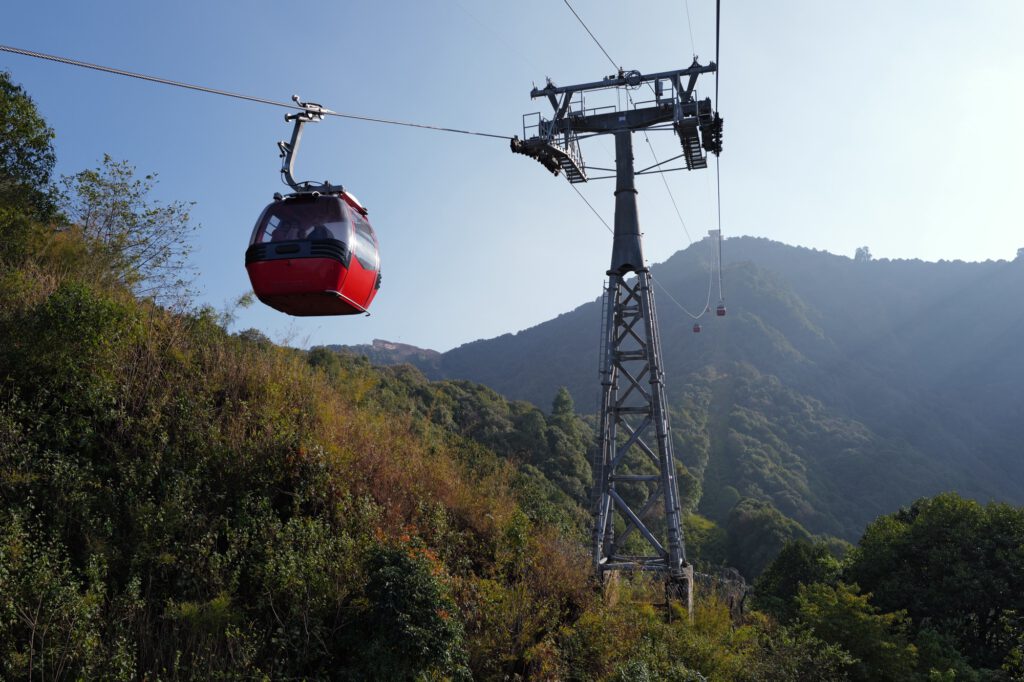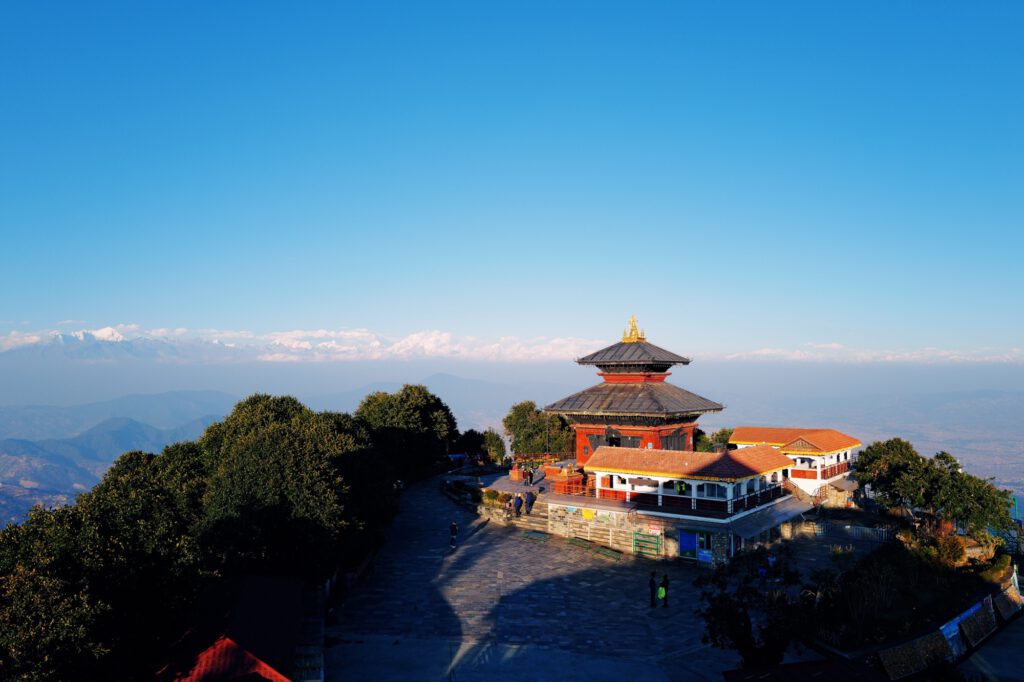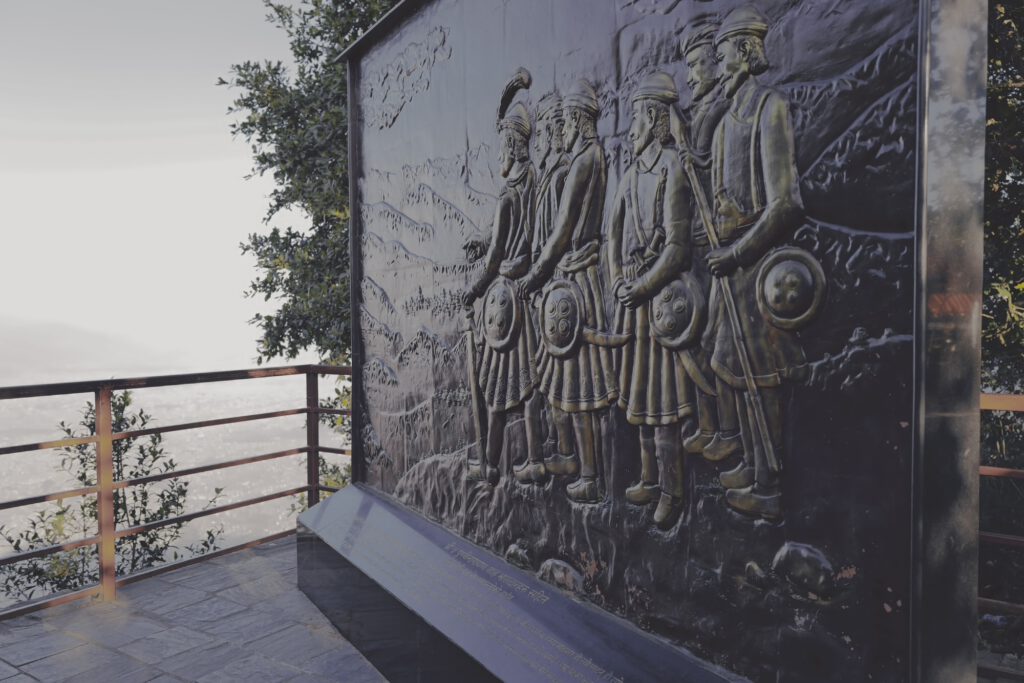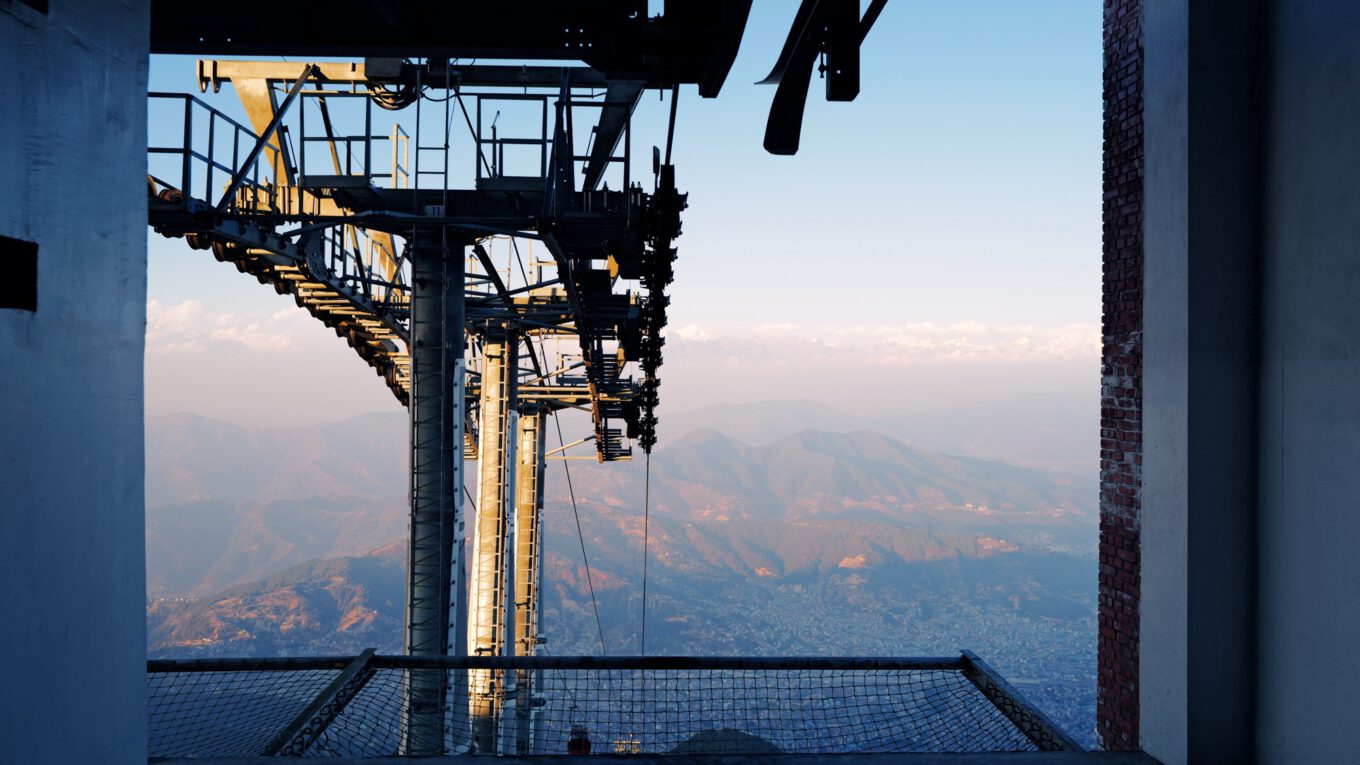Chandragiri-Hügel – Ein Panorama zwischen Geschichte und Natur
Gestern, an einem klaren Mittag, boten die Hügelketten im Westen des Kathmandu-Tals von meinem Haus im Norden der Stadt einen atemberaubenden Anblick. Die kristallklare Fernsicht inspirierte uns zu einem spontanen Ausflug zum Chandragiri-Hügel. Seit 2016 bringt dort eine Seilbahn, errichtet von der österreichischen Firma Doppelmayr, Besucher auf eine Höhe von 2.551 Metern – ein beeindruckender Aussichtspunkt mit einem unvergleichlichen Panoramablick über das Kathmandu-Tal.

Die Seilbahn erstreckt sich über eine Strecke von 2,5 Kilometern und überwindet einen Höhenunterschied von etwa 1.000 Metern in rund zwölf Minuten. Der Ausflug ist ein absolutes Highlight für alle, die Nepals landschaftliche Schönheit erleben möchten. Die Anlage gehört zu den modernsten der Region und stärkt den Tourismus in und um Kathmandu erheblich. Im Vergleich dazu weist die deutsche Seilbahn zur Zugspitze eine ähnliche Streckenführung und Bedeutung auf.
Oben angekommen, umfing uns die frische, kühle Bergluft – ein wohltuender Kontrast zur staubigen Hitze der Stadt. Der Himmel strahlte in einem intensiven Blau, und vor uns erstreckte sich die schneebedeckte Himalaya-Kette in voller Pracht. Im Westen ragte das majestätische Annapurna-Massiv auf, im Osten zeigte sich der legendäre Mount Everest. Dazwischen reihten sich weitere Achttausender wie der Dhaulagiri, der Manaslu und der Lhotse. Ein Anblick, der uns für einen Moment innehalten ließ – als wäre die Zeit eingefroren.
Ein weiteres Highlight des Chandragiri-Hügels ist der Bhaleshwor Mahadev Tempel. Der Legende nach ist der Tempel der Gottheit Shiva gewidmet und soll Segen für Wohlstand und Glück spenden. Besucher berichten oft von einer besonderen Ruhe, die diesen Ort umgibt.

Während wir den Gipfelbereich erkundeten, begegneten wir zahlreichen Familien und wenigen Touristen. Viele nutzten die Gelegenheit für Fotos vor dem eindrucksvollen Hintergrund des Himalayas. Eine fröhliche Lebendigkeit erfüllte den Platz, doch gleichzeitig blieb die Atmosphäre friedlich und respektvoll.
Der Chandragiri-Hügel ist nicht nur für seine spektakuläre Aussicht bekannt, sondern auch für seine historische und kulturelle Bedeutung. Im Jahr 1768 spielte dieser Ort eine zentrale Rolle in der Vereinigung Nepals. Prithvi Narayan Shah, der König von Gurkha, erklomm diesen Hügel während seiner Eroberungskampagne. Von hier aus blickte er erstmals auf das Kathmandu-Tal und erkannte die strategische und wirtschaftliche Bedeutung dieses fruchtbaren Landstrichs.

Damals war das Kathmandu-Tal in drei eigenständige Königreiche aufgeteilt: Kathmandu, Patan (Lalitpur) und Bhaktapur. Die rivalisierenden Könige dieser Stadtstaaten standen in ständigem Konflikt miteinander, was sie gegenüber äußeren Bedrohungen schwächte. Prithvi Narayan Shah nutzte diese Zersplitterung und führte eine geschickte militärische und diplomatische Kampagne, die schließlich zur Eroberung und Vereinigung des gesamten Tals führte. Chandragiri gilt daher als ein symbolischer Ort, an dem der Grundstein für das moderne Nepal gelegt wurde.
Noch heute erinnert eine Statue von Prithvi Narayan Shah auf dem Gipfel des Chandragiri-Hügels an seine visionäre Rolle als Einiger des Landes. Für viele Nepalesen ist dieser Ort nicht nur ein beliebtes Ausflugsziel, sondern auch eine Stätte der historischen Reflexion und des nationalen Stolzes. Die Aussicht vom Hügel vermittelt ein Gefühl der Verbundenheit mit den geografischen und kulturellen Wurzeln des Landes – genau wie einst für den König, der von hier aus sein künftiges Reich erblickte.
Dieser Ausflug führte mir einmal mehr vor Augen, wie vielseitig und faszinierend selbst das Kathmandu-Tal ist. Die Landschaft, die Kultur und die Spiritualität verschmelzen hier zu einem Gesamterlebnis, das seinesgleichen sucht. Für Reisende, die das Kathmandu-Tal besuchen, ist der Chandragiri-Hügel ein absolutes Muss – besonders an Tagen, an denen der Himmel klar ist und der Himalaya in voller Pracht erscheint. Ein Tipp für zukünftige Besucher: Früh aufzubrechen lohnt sich, um die Aussicht in Ruhe genießen zu können. Wir nahmen ein Taxi, dass die 29 Kilometer von Budhanilkantha nach Chandragiri in anderthalb Stunden bewältigte. Mit dem Bus hätte es wesentlich länger gedauert.
English version below
Chandragiri Hill – A Panorama Between History and Nature
Yesterday, around noon, the western hills of the Kathmandu Valley offered a breathtaking view from my home in the northern part of the city. The crystal-clear visibility inspired a spontaneous trip to Chandragiri Hill. Since 2016, a cable car built by the Austrian company Doppelmayr has been transporting visitors up to an elevation of 2,551 meters – a spectacular viewpoint with a sweeping panorama over the valley below.

The cable car covers 2.5 kilometers and climbs about 1,000 meters in just under twelve minutes. It’s a highlight for anyone wanting to experience Nepal’s natural beauty. Among the most advanced systems in the region, it has significantly boosted tourism in and around Kathmandu. For comparison: the German Zugspitze cable car offers a similar route and role in mountain tourism.
At the top, we were greeted by fresh mountain air – a welcome contrast to the dusty heat of the city. The sky shone a deep blue, and before us lay the snow-covered Himalayan range in all its glory. To the west rose the majestic Annapurna massif; to the east, the legendary Mount Everest. In between, other giants like Dhaulagiri, Manaslu, and Lhotse lined the horizon. The view was so striking, it felt as though time had paused for a moment.
Another highlight at the summit is the Bhaleshwor Mahadev Temple. According to legend, it is dedicated to the god Shiva and is said to bring blessings of prosperity and happiness. Many visitors speak of a unique tranquility that surrounds the temple.

As we explored the summit area, we encountered many local families and a handful of tourists. People posed for photos with the majestic Himalayas in the background. There was a cheerful energy in the air, yet the mood remained peaceful and respectful.
Chandragiri Hill is not just known for its stunning views – it also holds great historical and cultural significance. In 1768, it played a pivotal role in the unification of Nepal. Prithvi Narayan Shah, the King of Gorkha, climbed this hill during his conquest of the valley. From here, he saw Kathmandu for the first time and recognized its strategic and economic importance.

At the time, the Kathmandu Valley was divided into three rival kingdoms: Kathmandu, Patan (Lalitpur), and Bhaktapur. Constant conflict between these city-states left them vulnerable to outside threats. Prithvi Narayan Shah used this disunity to his advantage, launching a clever military and diplomatic campaign that eventually unified the valley. Chandragiri is thus seen as a symbolic birthplace of modern Nepal.
Today, a statue of Prithvi Narayan Shah still stands atop the hill, commemorating his visionary role. For many Nepalis, Chandragiri is not just a scenic spot, but also a place of national pride and historical reflection. The view from the top evokes a sense of connection to the land’s cultural and geographical roots – just as it once did for the king who envisioned a united nation from this very vantage point.
This trip reminded me once again how diverse and captivating even the Kathmandu Valley alone can be. Its landscape, culture, and spirituality blend into a rich, unforgettable experience. For travelers exploring the valley, Chandragiri Hill is an absolute must—especially on clear days when the Himalayas are on full display. A tip for future visitors: start early to enjoy the views without the crowds. We took a taxi from Budhanilkantha, covering the 29 kilometers in about ninety minutes. By bus, it would have taken much longer.
